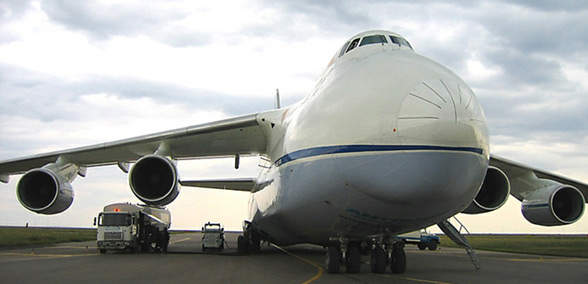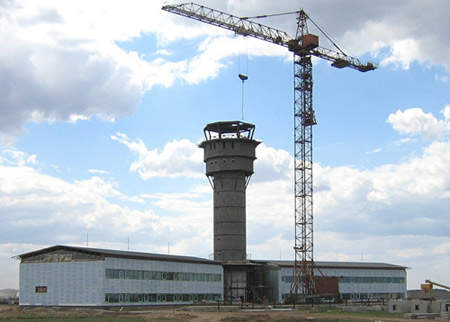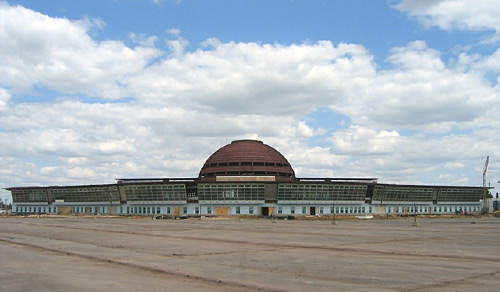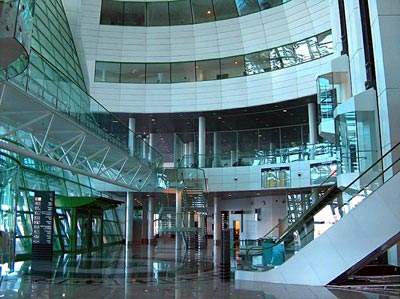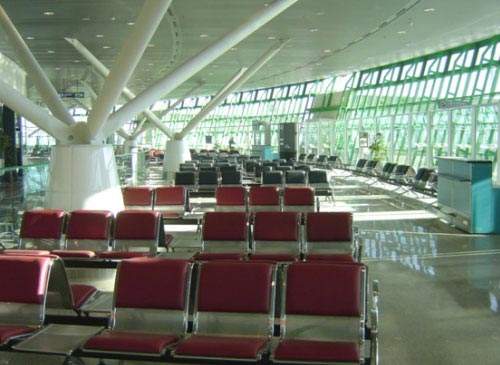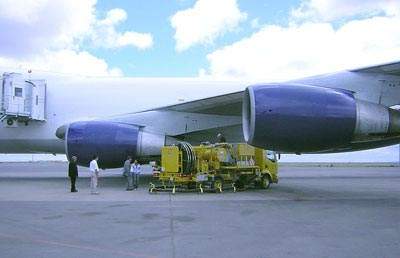Astana is the new capital city of Kazakhstan. It was developed rapidly during the later half of the 1990s and took on the status of ‘Capital’ in 1997. This was done because Astana was more centrally located than the previous capital, Almaty, and considerably less prone to seismic activity.
The new capital and the surrounding area was also designated a Special Economic Zone (SEZ), which allows foreign and domestic companies and investors special privileges including exemption from taxes, duties and tariffs for up to ten years. This new status has accelerated the economic development of the area and has required a corresponding development and improvement of the transport infrastructure in and around Astana.
ASTANA INTERNATIONAL RENOVATION
The airport renovation project was part of the Public Investment Program and National Development Plan instigated in the ‘Three Regional Airport Modernisation Project’ in 1998 and started in 2002.
The new passenger terminal was opened in March 2005 and began regular operations with the final flights being transferred from the old terminal at the beginning of April 2005. The old terminal has now been decommissioned, in readiness for further expansion if required.
The original airport facilities were designed as a regional airport serving domestic passengers and cargo needs only, but the upgrade has provided unrivalled new facilities to give it full international status.
The airport has formed an important hub for cargo and passenger transport between Europe and Asia following a growth of passenger traffic during 2005 of 7.5%. Passenger traffic is expected to grow by another 5% in the next decade and cargo traffic by up to 10%.
FINANCE OF THE PROJECT AND OPERATING COMPANY
The renovation project was partly funded by the Yen credit project, provided by the Japanese government to Kazakhstan as economic support; the Yen credit total is in excess of ¥23.4bn.
The airport renovation project was one-third funded by the Kazakhstan government and two-thirds funded by Japanese economic aid (OECF) provided via the Japanese International Development Bank. The final estimated cost of the project was ¥35.1bn.
The company running the airport is International Astana Airport and the body responsible for regulation of aviation standards and affairs is the Committee for Air-Space Utilisation and Civil Aviation, which was formed in 1997.
AIRPORT CONTRACTORS AND CONSTRUCTION
The architectural and design contract was awarded to Kisho Kurokawa Architect and Associates (KKAA) of Japan and Pacific Consultants International (PCI). Kisho Kurakawa was also responsible for the Astana Development Master Plan.
The general construction contract for upgrading and renovation of the airport was awarded to a consortium of four companies (SMLA) in early 2002. The consortium included Marubeni Corporation of Japan, Siemens AG of Germany (Siemens Airports and Siemens Airfield Solutions), John Laing PLC of the UK and Alsim Alarko AS of Turkey.
The contract covered the extension of the runway, an expansion and paving of the guide routes, apron areas and taxiways to international standard, the construction of the new passenger terminal and cargo terminal buildings and a new aircraft control tower.
In addition, the contract included an upgrade of the existing road infrastructure, emergency fire facilities and services, a new international standard security system and an upgrade to air-navigation facilities, such as radar, communications, air traffic control system, navigation and runway lights and meteorological facilities. The airport is now fully compliant with all International Civil Aviation Organisation (ICAO) standards.
Krantz Komponenten of Aachen in Germany supplied over 895 adjustable air induction outlets (IN-V2) for the air conditioning system via a Turkish company, EMO Teknil Testisat Ltd. These were installed right across the new terminal along with 30 adjustable radial outlets. Dinamik Proje of Istanbul was subcontractor for mechanical design at the airport.
Only 47% of the required construction materials (wood, cement, bricks and some steel work) were available in Kazakhstan; other materials had to be imported from Germany, Turkey and China.
RUNWAYS, TAXIWAYS AND ROADS
Astana Airport was designed to handle not only large passenger aircraft such as the Boeing 747-400 and the Airbus A340 but also large-capacity wide-body aircraft (IL-76, AN-124, B747-400F).
The new apron is 215,000m² and constructed of asphalt and concrete to the PCN 56-71 F/C/X/T standard. Two runways, 04 and 22, were completed in August 2003 and these are both 3,500m long and 45m wide, constructed of asphalt and concrete paving and built to the PCN 79 F/C/W/T standard.
The International Civil Aviation Organisation (ICAO) has adopted the standard Aircraft Classification Number/Pavement Classification Number (ACN/PCN) method for reporting pavement strength. The ACN is a number that expresses the demand an aircraft places on a pavement. The PCN is a number that expresses the capability of a pavement to support aircraft – Six taxiways (designated 1, 2 and 3, C, D and E) were improved; these ranged in size from 1,350m × 24m to 256m × 44m.
In addition, road access to the new passenger and cargo terminals was upgraded to asphalt and parking space for more than 420 vehicles was constructed. One problem still to be solved and which is being planned currently is transportation to the airport from the capital.
PASSENGER AND CARGO TERMINALS
The passenger terminal consists of a basement level, two basic passenger levels and three VIP levels (building area 9,260m² and floor area 23,892m²). The central concourse is situated in a dome 45m in diameter and 36m in height, based on the shape of a traditional Kazakhstan moveable house called a ‘Yurta’. The exterior of the dome was clad in two types of blue Islamic mosaic tiles to express the colours of the national flag and the Islamic identity of the country.
The passenger terminal has a frontage of 252m and a capacity of 750 passengers at peak hours. The terminal has six air bridges for passenger arrival and departures. One of the air bridges has a dual tunnel arrangement for disembarkation from two doors of an aircraft simultaneously.
There are two panoramic and nine normal elevators along with two escalators for easy movement of passengers around the facility.
The check-in area has 25 desks, 12 for international flights, ten for domestic flights and three for VIPs. There are seven customs control counters, 26 passport control counters and ten security screening points for passenger convenience.
The passenger and motor vehicle entrance is located at the first level of the terminal inside a spheroid structure, which protects passengers and their luggage from inclement weather. The design inside the dome gives an open space up to the top of the spheroid including perimeter mezzanines on each level, with crossings on chords at different levels, with transparent luggage and passenger channels.
On the third and the fourth floors there are six retail areas and two duty free shops, three food courts, entertainment areas, game rooms and rest lounges. The upper floor houses restaurants, cafes, bars and an observation platform. The dome is lit in such a way that it provides a distinctive visual indicator of the airport at night.
The terminal has a transit hotel with 16 rooms. The waiting areas have 230 seats in the pre-check-in area and 1,232 seats in the departure lounges.
Systems installed in the new terminal include an international check-in system running on Common Use Terminal Equipment (CUTE) and an international audiovisual Flight Information Display System (FIDS), which was supplied and installed by SITA and which controls over 100 LCD screens around the terminal.
The terminal also installed the latest IT for security (differential access) and baggage handling and screening. There are separate transport lines for the segregation of suspicious material.
The cargo terminal is a two-tier building with a warehouse capacity of 600t and a daily turnover of 300t.
The project also incorporates a new two-storey building for air navigation and an air traffic control tower 40m high. There is also a new building for the base of the airfield services department and a new fire station in addition to the original one.
NAVIGATIONAL, LIGHTING SYSTEMS AND REFUELLING
The runways have been equipped with high-intensity IDMAN lighting systems equipped with the PAPI visual navigation aid (ICAO CAT II), supplied and installed by Siemens. An upgrade of the lighting system to ICAO category III to allow ‘blind’ landing of aircraft in low visibility was carried out in early 2006.
The navigational systems have also been upgraded to MRL-5 radar, Mitras RVR, CT25K, FD12P and Milos 500 (developed by Vaisala Oy of Finland).
Refuelling facilities include one 60,000l (45psi, 2,400l/min, two hoses) and six 22,000l (45psi, 1,600l/min, two hoses) fuel reservoirs with full fuel filtration and laboratory testing facilities.
A new central hydrant fuelling system at the new terminal was installed in January 2005; the system has been in use since the terminal opened but it was trialled in October 2005 for fuelling larger wide-bodied aircraft. The system was able to fuel a wide-bodied aircraft with 100 t of fuel in less than 50 minutes.
As the airport upgrade has now been completed with two new fire rescue stations the fire rescue category has been upgraded from category VIII to category IX.
ENVIRONMENTAL CONCERNS
Although concerns have been raised over the environmental implications of both the airport expansion and the projected increase in air traffic, it is expected that there will be a minimal effect on the environment.
This is due to several factors: firstly, windy conditions at the airport will prevent a deterioration of the air quality by aiding removal of any concentration of chemical substances resulting from airport activity; secondly, the airport is situated far enough away from habitable areas so that noise pollution is not an issue; finally, the area around the airport is not scientifically significant to ecologists, although every effort will be made to preserve the habitats of resident wildlife.
The buildings have been constructed as safe and comfortable areas designed to withstand the extremes of temperature experienced in Kazakhstan, which range from -40°C in winter to 40°C in summer.
AIR ASTANA
The national airline of Kazakhstan began operations in May 2002; Air Astana is the largest airline in Kazakhstan. The airline’s main bases are Astana International Airport and Almaty Airport. The government owns 51% and BAE Systems Ltd of the UK owns 49%.
Air Astana operates three Boeing-737-700/800, four Boeing 757-200 planes for international flights from Astana and five Fokker-50 turbo prop planes to cover the domestic market.
The airline currently operates to cities across Europe and also to destinations in the Far East. After the demise of Air Kazakhstan in 2000 it was felt a matter of pride to establish a new national airline and so to go with the new terminal Air Astana was launched.

